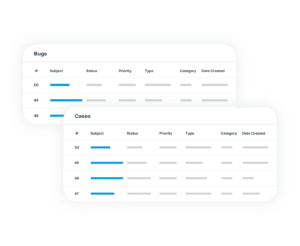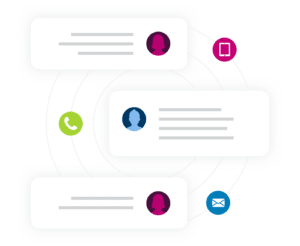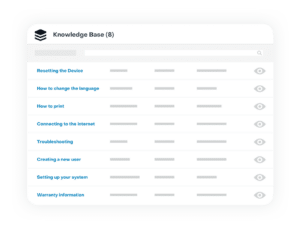What Is Customer Support and How to Improve Yours?
It’s just a fact of doing business—your customers will need help at some point. Whether it’s about your products, their account, or something else, customer support is the way they get answers to their most pressing questions. But what does it mean to provide the best customer support, and what can you do to improve yours?
Let’s take a look at what customer support means and the tips, tricks, and best practices you can implement to build an even better customer experience (CX).
What is Customer Support?
Customer support is your team’s assistance when your customers run into roadblocks when using your products or services.
The greater purpose of customer support? To continue building positive interactions with customers long after purchase. The benefit of customer support isn’t just a one-way street. Creating the best customer support center gives you insight into who your customers are, how they use your products and services, how your offerings can improve, and so much more.
Customer Support vs. Customer Service: Are They the Same?
Customer support and customer service may seem the same, but they’re not. Customer service encompasses all parts of the customer experience (from tech support to strategic services to loyalty). Customer support is one part of the customer service umbrella.
While all businesses provide some level of customer service, not all provide support (or need to). Consider a movie theater whose staff will provide service by taking your ticket and selling you popcorn but won’t lend support in helping you pick the movie.
In short, support helps solve one-time issues, while service contributes to the overall customer experience to build long-lasting relationships.
Types of Customer Support Solutions
With more outstanding digital options and accessibility than ever, customer support can come in several forms:
- Phone
- Social media
- Live chat
- Apps
- In-person
Beyond these channels, customer self-service allows your users to find support on their own with on-demand resources like knowledge bases, FAQs, discussion forums, portals, and even AI-supported chat through bots. Self-service can help customers address common inquiries such as:
- Account balances and payments
- Account preferences and changes
- How-tos for simple tasks and products (e.g., activating your new card)
- Appointments and service dates
- Training and demos
- Access to important documents
- Company hours and basic information
- Logging a ticket for further help
Tips and Best Practices: How to Improve Your Customer Support
What constitutes the best customer support? We believe it’s interactions that create outstanding experiences for customers while streamlining your entire service process. Some of the top ways to improve your customer support include the following best practices:
1. Make it easy for customers to get support.
Every customer’s support preference is different. Make it easy for customers to find support by offering multiple channels to reach your team. Display phone numbers and email addresses prominently on your support page, and include links or buttons to launch live chat (if applicable). Customers shouldn’t have to go searching for answers. The added convenience of easy support access can improve their brand experience drastically.
2. Offer self-service support options.
Today, more than 60% of U.S. consumers say their go-to channel for simple inquiries is a digital self-serve tool. Let customers move at their speed with on-demand FAQs, a knowledge base, or a portal of customer support information. They’ll be able to bypass long wait times while you receive the benefit of reduced call center costs and agents who can focus on fewer cases with more complex customer issues.
3. Make sure your customer support team has the right tools and resources.
Your customer support staff can’t do their best work without the data and tools they need to help customers efficiently. Customer support software makes it easier to manage multiple support channels under one umbrella and gives agents the information they need to quickly solve challenges and improve customer experience. Look for customer support solutions that offer intelligent case prioritization and routing, intuitive dashboards, and seamless self-service options. Even better, seek out AI-backed solutions that can assess customer sentiment so you can accurately triage cases.
4. Use data to improve continually.
Don’t just gather data. Use it—not only for resolving customer issues but improving your support. Activate your data by benchmarking, setting goals, and course correcting. Assess call center KPIs like the number of cases, response times, average time to resolution, and customer satisfaction score. The right customer support software makes it easy to automatically gather this data, make operational changes when necessary, and improve your stats for overall customer service.
5. Hire support staff with a mix of technical skills and soft skills.
Customer service reps are unique to any other role you may hire because of the mix of skills required for both technical resolution and building relationships. Customer support agents are the true face of your company, regularly meeting customers on the front lines and interacting with them at their most vulnerable times. Meeting these needs requires skills not typically required in other roles throughout the company, including patience, emotional intelligence, problem-solving, creativity, and persuasion. At the same time, support agents must be well-educated on your products/services and masters of time management to get the job done efficiently. Seek out candidates with these skills, and spend time training current staff to hone them further.
Want to Improve Customer Support? Sugar Serve Can Help
At Sugar, we believe customer experiences should match expectations. Our customer support software has everything you need to create an outstanding customer experience while streamlining customer service processes. In one console, you can:
- Reply to emails and customer queries without leaving the platform
- Embed omnichannel customer communication capabilities
- Prioritize customer issues by SLA, priority, and severity
- Gauge, understand and even predict customer sentiment and behavior
- Deflect more calls with self-service options
- Automatically route inbound requests to the right person
- Identify problem areas before they become major issues with robust tracking
- Chart trends over time to measure and improve performance

Whether they need to update their account information, get technical help, or schedule on-site maintenance, the best customer support is helpful, easy, and friendly—keeping them engaged and ready to cheer on your brand.
See the difference Sugar Serve makes for yourself by requesting a demo today.



